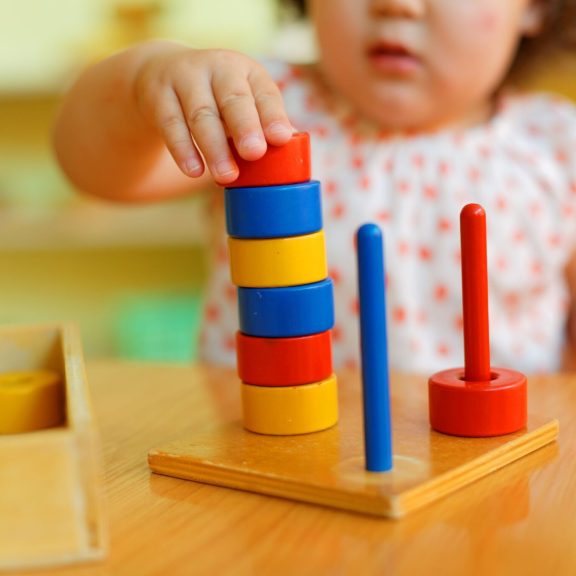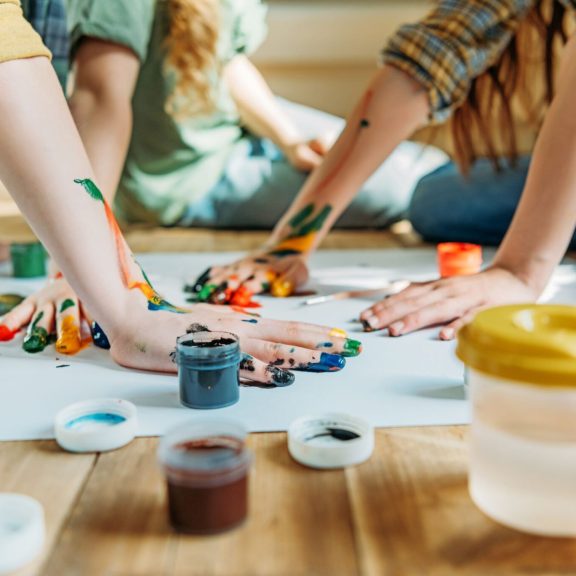The Montessori Method
The Montessori method is Maria Montessori's pedagogical proposal, based on the scientific observation of children: their various stages of development throughout life, their potential, their interests and their abilities.

What is the Montessori method ?
The Montessori method is Maria Montessori‘s pedagogical proposal, based on the scientific observation of children: their various stages of development throughout life, their potential, their interests and their abilities.
The main characteristics of the Montessori Method are:
- Children should be free to develop and learn at their own pace, in a stimulating environment, with understanding and observation by the adult.
- The prepared environment provided to the children: orderly, beautiful, of adequate size, real, etc. where each element has been selected for a specific reason for their development.
The Montessori method can be implemented as a whole and in its entirety or introduced little by little in traditional educational settings, thus enriching daily educational practice.
Any environment where children are present is susceptible to be improved with this vision and practice of education.
The child is the center
Maria Montessori asserted that every educator must “follow the child”, recognizing the characteristics of each age stage as well as their specific educational needs.
Children need to adapt to their environment, so Dr. Montessori saw it as fundamental to build a favorable environment, both physically and spiritually. So that children are able to make sense of the world around them.
Montessori in the 21st century
Although it is an observation carried out at the beginning of the 20th century, it is a pedagogy with wide international recognition even 100 years later.
Current scientific research continues to validate this educational method as a set of elements that help children in their holistic development of mind, body and emotions.

Basic principles of the Montessori Method
- Absorbent mind of children: they have the innate capacity to receive, process and store in the brain cells, and without any effort, everything that comes from the surrounding environment.
- Learning area: in a Montessori classroom the spaces are divided into different areas, which correspond to the five key areas of learning:
- Practical life
- Sensory
- Language
- Mathematics
- Culture
- Sensitive periods: these are periods when the child shows special interest or enthusiasm for learning a particular area. These sensitive periods are also called “learning windows”.
- Normalization: this is the process in which the child gradually achieves order, self-discipline and socialization, i.e., the ability to appreciate, respect and collaborate with others.
- Prepared environment: is the environment in which the child develops, both the physical space and the people with whom the child interacts, the activities and guidelines that arise in that space.
- Respect for the child’s learning pace: each child has a different pace and the adult must respect it, avoiding intervening or doing things in place of the child, as this hinders learning and causes a feeling of inferiority and frustration in the child.
- The role of the adult: his function is to guide the child, allowing him to set the pace guided by his interests and thus favoring both the child’s physical and thinking autonomy.
- Montessori materials: these are tools for manipulation and sensory experimentation by the child, in order to develop knowledge and abstract thinking.

How to implement the Montessori Method?
From our training center we offer all the tools so that both teachers and families can successfully implement Montessori Education in the classroom, at home or any other educational space, taking into account the following:
- The impact of movement on learning. Meaningful movement is an aid to learning and improves the ability to retain concepts; the use of the hands is a magnificent channel of information input to the brain.
- Choice and perceived control. Any learning is deeper and easier when we choose what we want to learn and can monitor that learning.
- Rewards and extrinsic motivation interfere with learning. It is the intrinsic motivation of the person that is positive and must be encouraged.
- Learning from peers facilitates understanding. Peer-to-peer dialogue is a very powerful key for both the learner and the teacher.
- Meaningful learning contexts: Any academic subject is susceptible to be treated in a meaningful way and this enhances the intensity of what is learned.
- Education should above all encourage the development of our executive functions: planning, deciding, imagining, self-correcting, self-awareness or choosing strategies, among others; this is only possible with the real practice of these skills.
- Order in the environment (physical, temporal, etc.) helps to build an orderly brain.
Many other elements that make up Montessori education, such as the importance of physical order to build mental order, or the importance of eliminating stress, among others, have been validated as essential for a healthy and balanced development.
From International Montessori Institute (IMI) we teach the principles and pedagogical practice of Montessori education and current scientific evidence, to contribute with concrete proposals for professional training to improve the quality of education.
